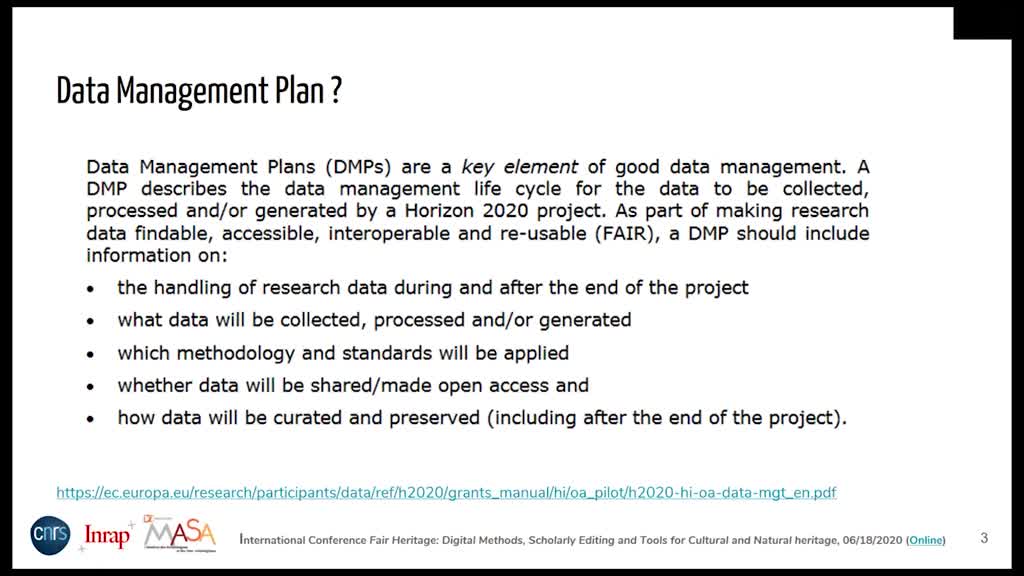Notice
Dr George Bruseker - Realizing the Virtues (and Combating the Vices) of the Digital Shift in Heritage Scholarship: the Role of Knowledge Representation
- document 1 document 2 document 3
- niveau 1 niveau 2 niveau 3
Descriptif
George Bruseker is Vice Chair of the CIDOC CRM Special Interest Group and an expert in the field of knowledge representation and semantics for cultural heritage. He has a PhD in Philosophy from the National and Kapodistrian University of Athens and has worked in diverse institutions within the field of cultural heritage and heritage research over the past fifteen years. He is deeply involved in the semantics community, participating in several major initiatives aiming to facilitate the adoption of semantic data including Data for History (d4h), Linked.Art, and the Arches Resource modeling Working Group (ARM WG). His research interests include the pedagogy of knowledge representation, semantic data workflow management and the modeling of art and architectural historical data.
Dans la même collection
-
Prof. Douglas Tudhope - Reflections on the semantic integration of archaeological datasets and grey…
TudhopeDouglasProf. Douglas TUDHOPE University of South Wales - UK Co-author: Ceri BINDING AHRC funded STAR, STELLAR and SENESCHAL projects (Semantic Tools for Archaeological Resources), in collaboration with
-
Nathalie Le Tellier-Becquart, Emmanuelle Bryas, Emmanuelle Morlock – DMP MASA
Le Tellier-BecquartNathalieBryasEmmanuelleMorlockEmmanuelleNathalie Le Tellier-Becquart, MSH Mondes - FR Emmanuelle Bryas, French National Institute for Preventive Archaeological Research - FR Emmanuelle Morlock, HiSoMA - FR
-
-
Dr Marianna Simoes - Primary data and Entomological collections: utility, best practices and challe…
SimoesMariannaDr Marianna SIMOES Senckenberg German Entomological Institute (SDEI) / University of Hamburg - DE I'm an evolutionary biologist with research foci lying at the intersection of phylogenetics, spatial
-
Prof. Ana Roxin - Semantic-based BIM Modelling : Approaches and related Standardization Actions
RoxinAnaDr Ana Roxin University of Burgundy (UBFC), Computer Science Laboratory of Burgundy (LIB) - FR Ana Roxin is Associate Professor in Computer Science, habilitated to conduct research, at the University
-
Dr Stéphanie Satre - Epicherchell, an epigraphic dataset to share and publish
SatreStéphanieDr Stéphanie SATRE Centre Camille Jullian - FR Stéphanie Satre is an engineer for the CNRS working on sources’ analysis and database conception. Member of the Centre Camille Jullian since 2010. She is
-
Mériç Akdogan, Pauline Bellemere et Inoussa Kora Chabi - DiVE Project
AkdoganMériçBellemerePaulineKORA CHABIInoussaFlash talk
-
FAIR Heritage : Official Opening
RodierXavierMaria SanfilippoEmilioDr Emilio Maria Sanfilippo, LE STUDIUM Research Fellow / ARD 2020 INTELLIGENCE DES PATRIMOINES Programme
-
Dr Sara Tonelli - What NLP can do for Metadata Quality: The Case of Descriptions in Cultural Herita…
TonelliSaraDr Sara TONELLI Bruno Kessler Foundation (FBK), Trento - IT Sara Tonelli is the head of the Digital Humanities research group at Fondazione Bruno Kessler in Trento, and adjunct professor of Language
-
Florian Hivert - ROSER - Répertoire de l’Ornement Sculpté des Édifices de la Renaissance: An intero…
HivertFlorianFlorian HIVERT Center for Advanced Renaissance Studies (CESR) / CNRS, University of Tours - FR Student in the M.A program Intelligence des données de la culture du patrimoine at the Centre d’Études
-
Prof. Elena Pierazzo - The edition of draft manuscripts: theories, (data) models and methods
PierazzoElenaProf. Elena PIERAZZO Center for Advanced Renaissance Studies (CESR) / CNRS, University of Tours – FR Elena Pierazzo is Professor of Digital Humanities at Centre d’Études Superieures de la Renaissance,
-
Prof. Julian D. Richards - Making Archaeology FAIR: in the Archaeology Data Service and ARIADNE
RichardsJulian D.Prof. Julian D. Richards Department of Archaeology, University of York - UK Julian Richards is Professor of Archaeology at the University of York. He is Director of the Centre for Digital Heritage,













